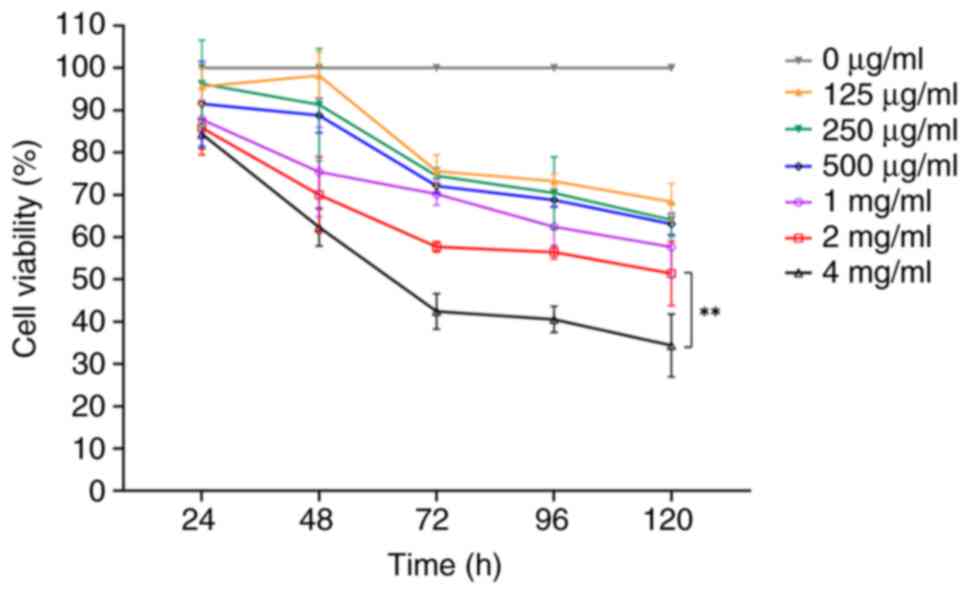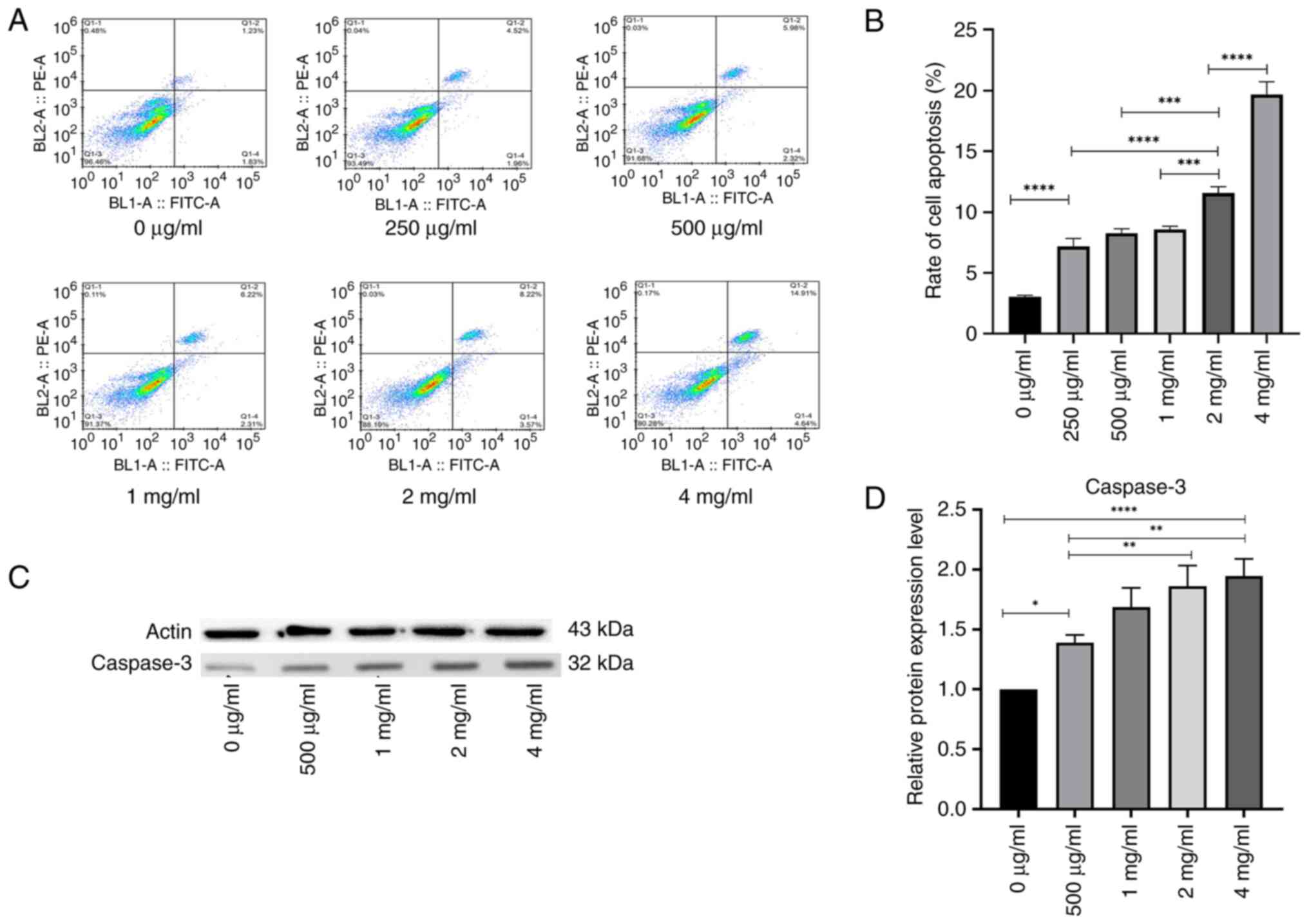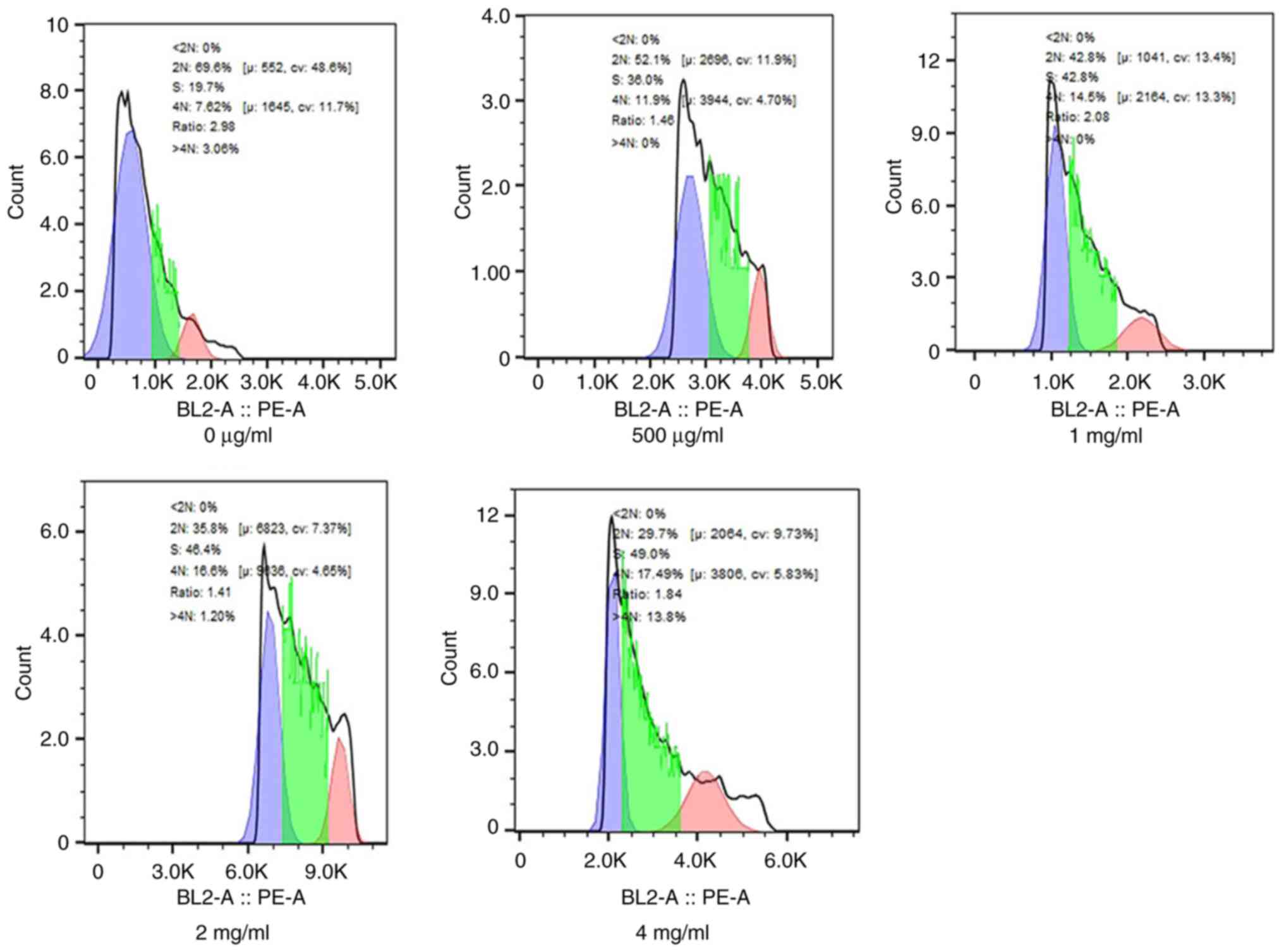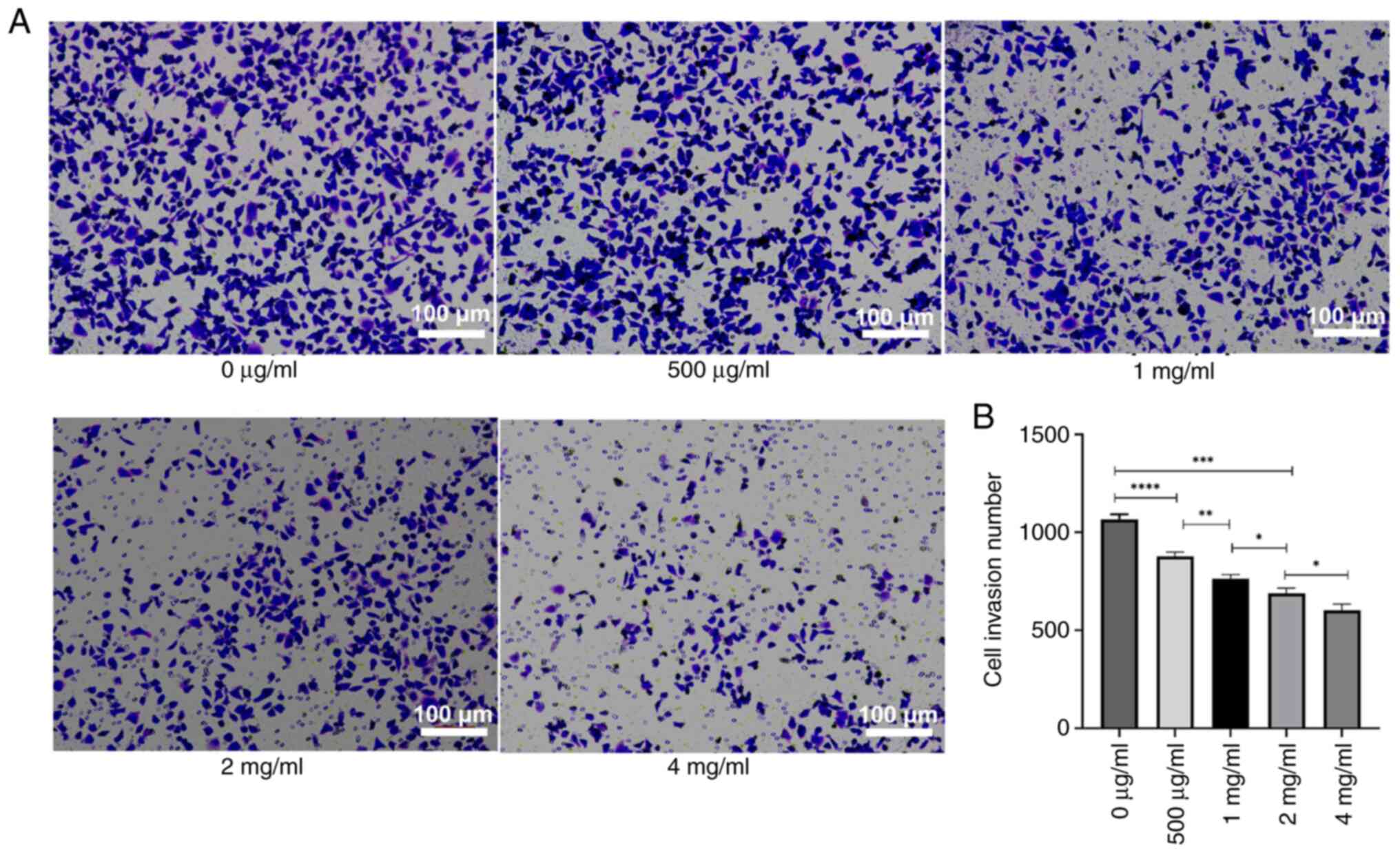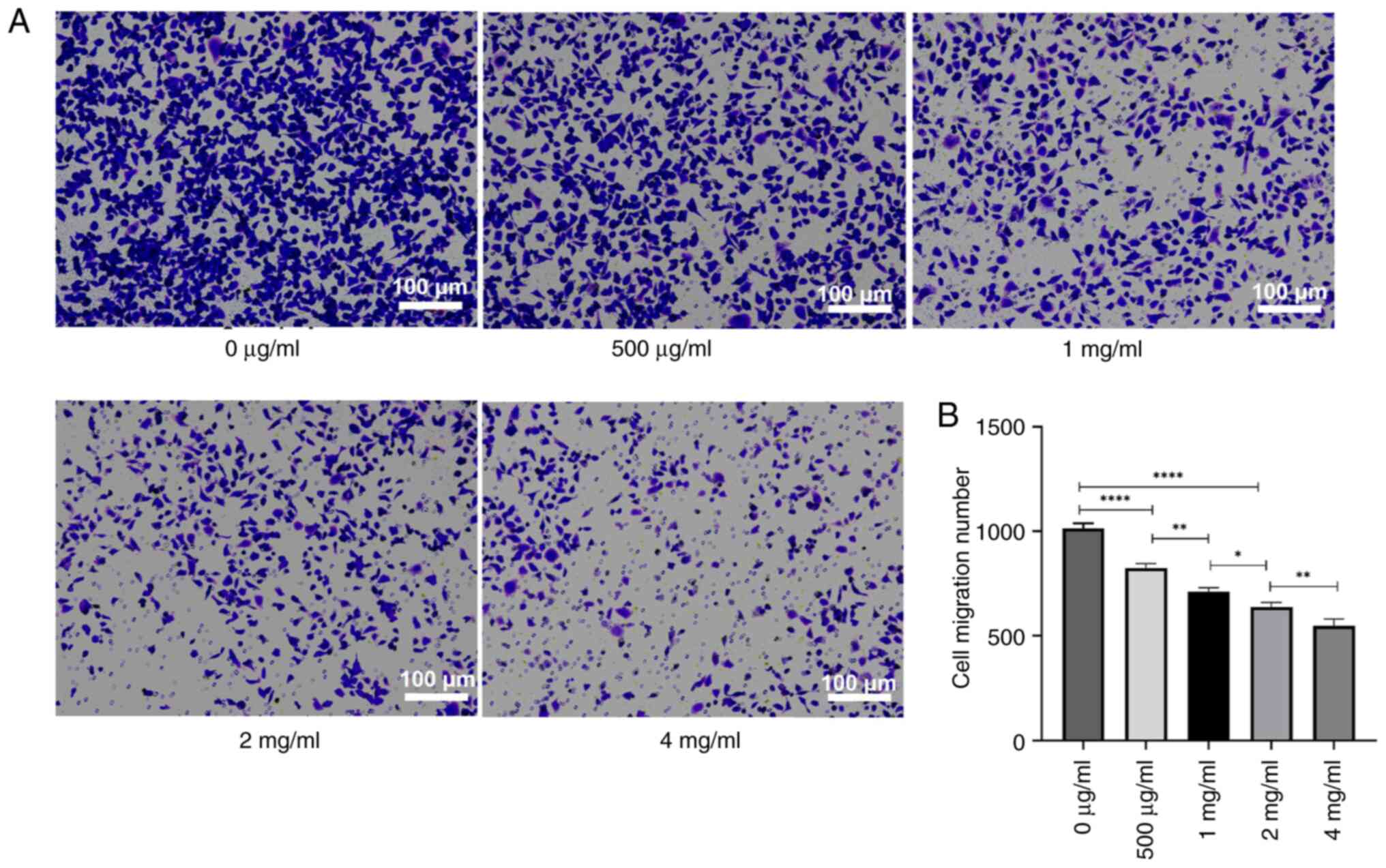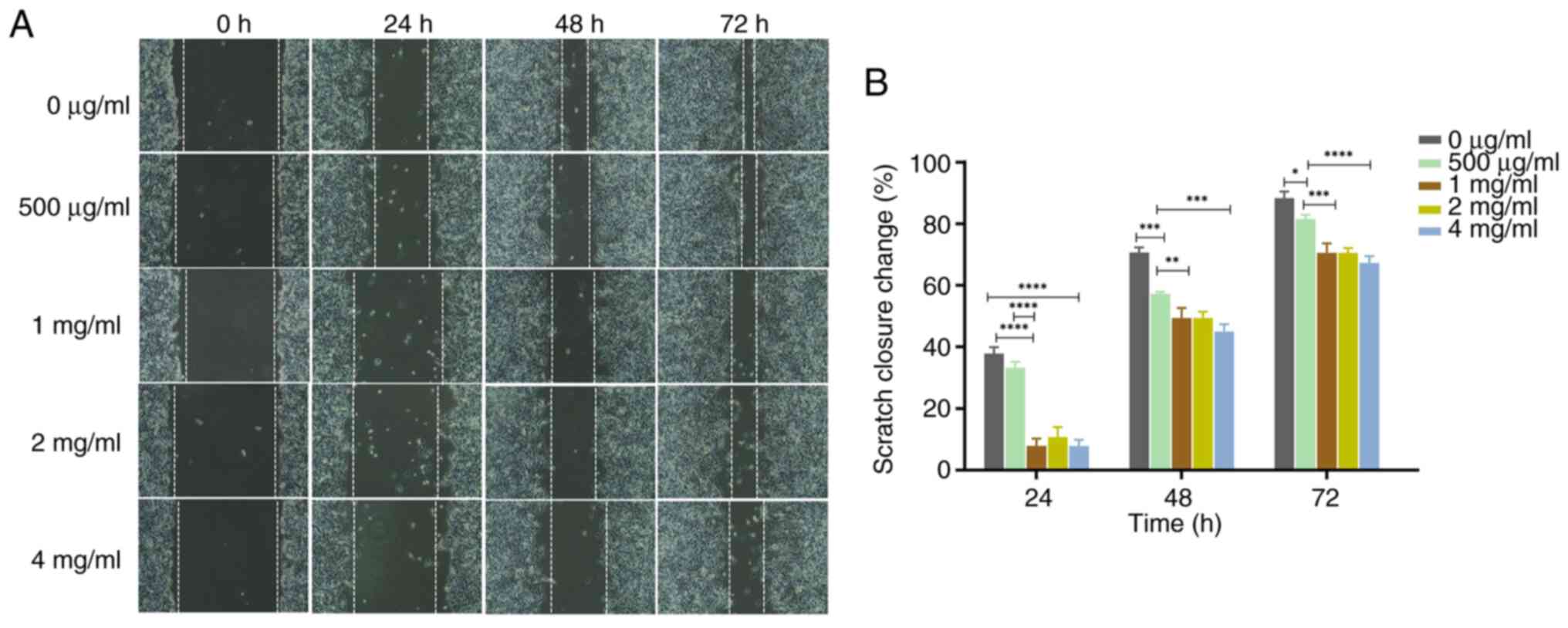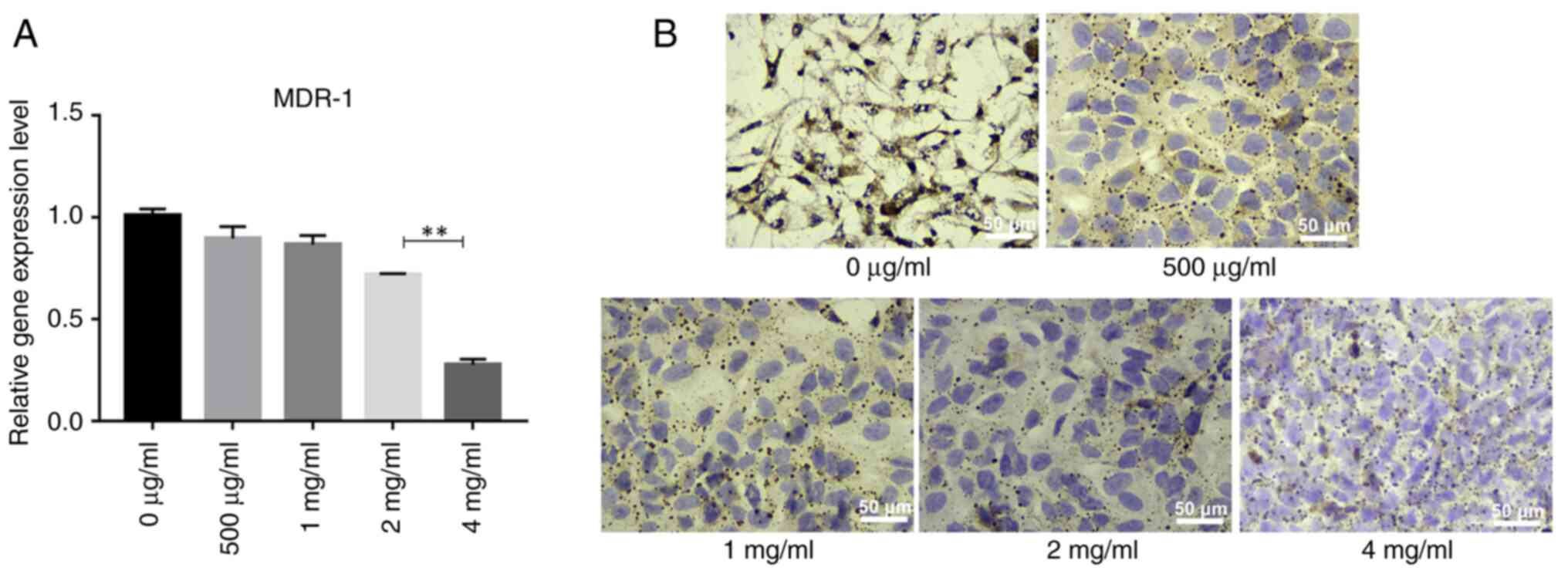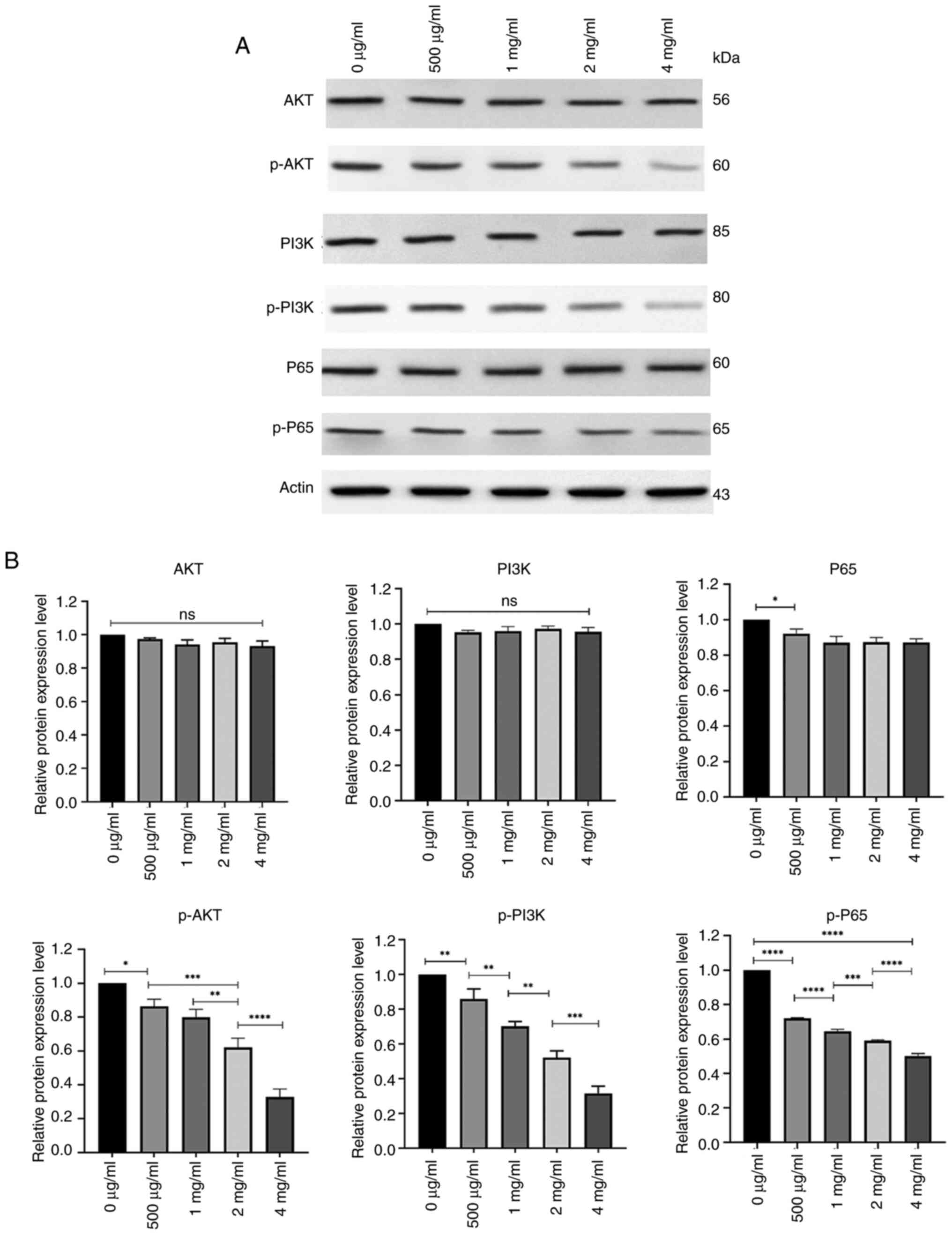Potential antitumor effect of polysaccharides extracted from Polygonatum sibiricum on human prostate cancer PC‑3 cells
- Authors:
- Published online on: October 25, 2024 https://doi.org/10.3892/ol.2024.14774
- Article Number: 28
-
Copyright: © Zhao et al. This is an open access article distributed under the terms of Creative Commons Attribution License.
Abstract
Introduction
Prostate cancer is the second-leading cause of cancer-related deaths in men worldwide (1). For early-stage prostate cancer, laparoscopic radical prostatectomy can provide effective treatment with the benefits of it being less expensive and minimally invasive (2), requiring only a small incision, and allowing for quick recovery after the operation. For recurrent or metastatic prostate cancer, radical surgery is not a suitable option. At the same time, androgen deprivation therapy is the current standard-of-care treatment (3), aimed at reducing the level of androgens and inhibiting their activity to delay the progression of prostate cancer. However, many patients with prostate cancer may gradually become unresponsive or resistant to androgen blocking, leading to the development of castration-resistant prostate cancer (CRPC), which is associated with high morbidity and mortality (4). CRPC is particularly challenging to treat due to its natural or acquired drug resistance, resulting in a poor prognosis (3). Therefore, it is necessary to elucidate new approaches to treat patients with advanced prostate cancer effectively.
Numerous studies have reported that Polygonatum sibiricum polysaccharides (PSP) possess pharmacological properties and biological activities (5), making them widely used in treatments of diabetes mellitus and its complications (6,7), as well as for their hypoplipidemic (8), anti-atherosclerosis (8,9), anti-osteoporosis (10) and anticancer (11,12) effects. Among these, the potential antitumor effects of PSP have attracted scientific interest due to its low toxicity and lack of side effects (11–14). A previous study reported that PSP notably inhibited the growth of prostate cancer-associated fibroblasts and enhanced the effectiveness of cancer therapy (13). Another study reported that PSP induced apoptosis in HepG2 cells and arrested the cell cycle at the G1 phase, indicating potential antitumor effects (14). Additionally, several studies have suggested that PSP can hold human gastric cancer HGC-27 cells, esophageal cancer ECA-109 cells and colorectal cancer HCT-8 cells in the S stage, thereby promoting their apoptosis (5,15).
Furthermore, studies have reported that the phosphatidylinositol 3-kinase (PI3K)/protein kinase B (PKB/AKT) signaling pathway is a key regulator of the cell cycle (16). Additionally, research has identified the PI3K/AKT signaling pathway as a significant player in prostate cancer tumorigenesis and therapy, influencing apoptosis, proliferation, metastasis and invasion of prostate cells (17–21).
The present study aimed to assess the effects of PSP on human prostate cancer PC-3 cells and elucidate the underlying mechanism involved.
Materials and methods
Cell culture and reagents
Human prostate cancer PC-3 cells were purchased from Procell Life Science & Technology Co., Ltd. The cells were cultured in Ham's F-12K media (Wuhan Pricella Biotechnology Co., Ltd.; Cat. CM0185) supplemented with 10% fetal bovine serum (FBS) (Gibco. Cat. 26140-079), 100 U/ml penicillin and 100 mg/ml streptomycin at 37°C in a humidified atmosphere containing 5% CO2. PSP was purchased from Shanghai Yuanye Biotechnology Co., Ltd. with a purity of 70%. The compounds were dissolved in PBS at a concentration of 20 mg/ml to prepare stock solution, which was stored at −20°C for in vitro studies. Before each assay, the stock solution was diluted with the medium.
Cell Counting kit-8 (CCK-8) assay
The effect of PSP on cell proliferation was assessed using the CCK-8 assay. Cells were seeded into 96-well tissue culture plates at a density of 1×104 cells/well and incubated at 37°C with PSP for 24, 48, 72, 96 or 120 h. Untreated cells served as the control. Following the treatment period, 10 µl CCK-8 reagent (Fluorescence, cat. no. DCM7122) was added to each well and then incubated for an additional 4 h at 37°C. The absorbance at 450 nm was measured using a microplate reader. Cell viability was determined by the following formula: Cell viability (%)=[(As-Ab)/(Ac-Ab)] ×100%, where As is the absorbance of PSP-treated groups, Ac is the absorbance of 0 µg/ml PSP-treated groups, and Ab is the absorbance of the blank group.
Flow cytometry
Based on the results of the CCK-8 assay, PC-3 cells were plated into 6-well plates at a density of 2×105 cells/well and treated with several concentrations of PSP solution (0, 250, 500 µg/ml, 1, 2 and 4 mg/ml) at 37°C for 72 h. The apoptosis rate of PC-3 cells was evaluated using the Annexin V-FITC/PI Apoptosis Detection Kit according to the manufacturer's instructions (Beijing 4A Biotech Co., Ltd. Cat. FXP018). Cultured cells were collected, washed with cold PBS and resuspended in a binding buffer. To this buffer, 5 µl Annexin V-FITC and 5 µl PI were added, followed by incubation at room temperature for 15 min in the dark. Annexin V-FITC binds to phosphatidylserine on the outer membrane of apoptotic cells, whilst PI penetrates and stains cells with compromised membrane integrity, binding to and labeling DNA. Data collection was performed using a flow cytometer (BeamCyte-1026; Bidaiko Biotechnology (Suzhou) Co.,Ltd, and the data were analyzed using FlowJo software 10.8.1 (BD Biosciences).
For the cell cycle assay, PC-3 cells were trypsinized, washed with cold PBS and fixed with 70% ethanol at 4°C overnight. The fixed cells were collected, resuspended in cold PBS and stained with PI. After staining, the cells were incubated for 30 min at 37°C in the dark. Data were collected using a flow cytometer (BeamCyte-1026; Bidaiko Biotechnology (Suzhou) Co., Ltd) and the data were analyzed with FlowJo software 10.8.1 (BD Biosciences).
Transwell invasion and migration assay
A Transwell assay was used to analyze cell invasion and/or migration. 2×105 cells treated with PSP (0, 500 µg/ml, 1, 2 and 4 mg/ml) were suspended in an FBS-free medium and 4×104 cells seeded into the upper chamber of 24-well plates, which were either coated with Matrigel at 37°C for 24 h (for invasion assays) or uncoated (for migration assays). The lower chamber was filled with a medium containing 10% FBS as a chemoattractant. After a 24-h incubation at 37°C, non-invaded or non-migrated cells on the upper surface of the membranes were carefully removed using cotton swabs, whilst cells that had transverse the membrane were fixed with 75% carbinol for 10 min at room temperature and stained using 0.1% Giemsa (Beyotime, C0133) for 10 min at room temperature. The stained cells were then counted under an invert light microscope (Leica DM3000).
Wound healing assay
PC-3 cells were seeded in 12-well microplates at a density of 1.5×105 cells/well and incubated at 37°C for 24 h (confluence reached 90–100%). Confluent monolayers were scratched with 10 µl tips. After washing with PBS, the cells were cultured at 37°C in low serum medium (0.5% FBS) with different concentrations of PSP (0, 500 µg/ml, 1, 2 and 4 mg/ml). Images of scratched areas were captured by fluorescence microscope at 0, 24, 48 and 72 h of incubation in the dark. Image J v1.8.0 software (National Institutes of Health) was used to analyze the cell migration distance. The migration inhibition rate was expressed as the % scratch closure change according to the following formula: Scratch closure change (%)=[(At0-Atc)/At0] ×100%, where At0 is the scratch area at time 0 and Atc is the corresponding scratch area at 24, 48 and 72 h.
Western blot
A total of 2×105 Cells treated with PSP for 72 h were harvested and lysed using RIPA buffer (Solarbio life sciences, Cat. R0010), and protein concentrations were measured using a BCA quantification kit. The lysates including 50 µg total proteins were then separated using 10% SDS-PAGE and transferred onto PVDF membranes (cat. no. ISEQ00010; MilliporeSigma; Merck KGaA), then blocked with 5% BSA (Solarbio life sciences, Cat. SW3015) at room temperature for 1 h. The membranes were incubated overnight at 4°C with primary antibodies (Affinity Biosciences, Ltd.) diluted at 1:1,000, including those targeting Akt (cat. AF6261), p-Akt (Cat. AF0016), PI3K (Cat. AF6241), p-PI3K (Cat. AF3241), caspase-3 (Cat. no. AF6311), P65 (Cat. AF5006), p-P65 (Cat. AF2006) and β-actin (Cat. AF7018). After being washed thrice with 1×PBS-T (1% Tween-20), the membranes were incubated with HRP-conjugated sheep anti-rabbit secondary antibodies (1:3,000, Medical Discovery Leader, MD912565) at room temperature for 1 h. Finally, the protein bands were visualized using enhanced chemiluminescence. The intensity of the bands was semi-quantified by the ChemiDoc MP Chemiluminescence Imaging System with Image Lab software 6.0.1 (Bio-Rad Laboratories, Inc.). β-actin was used as internal control.
Reverse transcription-quantitative PCR
2×105 PC-3 cells were treated with different concentrations of PSP (0, 500 µg/ml, 1, 2, 4 mg/ml) at 37°C for 72 h, after which total RNA was extracted using TRIzol reagent (Invitrogen; Thermo Fisher Scientific, Inc.). RNA concentration was determined using a NanoDrop™ 2000 spectrophotometer (Thermo Fisher Scientific, Inc.). A total of 1 µg RNA was then reverse transcribed into cDNA using the SuperRT cDNA Synthesis Kit (Jiangsu CoWin Biotech Co., Ltd. cat. CW0741m), with β-actin serving as the internal control, the condition for reverse transcription are incubated at 42°C for 30–50 min and at 85 ° C for 5 min. The expression levels of multidrug resistance-1 (MDR1) mRNA were assessed using the UltraSYBR Mixture (Low ROX; Jiangsu CoWin Biotech Co., Ltd.; cat. CW2601M). The data were normalized with β-actin using the following formula: Relative mRNA expression=2−ΔΔCq (22), where Cq is the cycle threshold. The primer sequences used were as follows: MDR1 (forward), 5′-TGCTCAAGTTAAAGGGGCTA-3′ and (reverse), 5′-CAGTGTTAGTTGCCAACCAT-3′; and β-actin (forward), 5′-TCCTCCTGAGCGCAAGTACTCC-3′ and (reverse), 5′-CATACTCCTGCTTGCTGATCCAC-3′. The thermocycling conditions were as follows: Pre-denatured at 95°C for 5 min, 40 cycles at 95°C for 10 sec, 58°C for 20 sec and 72°C for 20 sec.
Immunocytochemistry
PC-3 cells were seeded into 6-well plates with sterile slides at a density of 2×105 cells/well, treated with several concentrations of PSP solution (0 and 500 µg/ml and 1, 2, 4 mg/ml) at 37°C for 72 h, fixed with pre-cooled 4% paraformaldehyde at room temperature for 20 min, and then blocked with 10% goat serum (Beyotime, C0265) for 30 min at 37°C. The slides were subsequently stained with MDR1/P-glycoprotein (P-gp) primary antibodies (1:1,000; Affinity Biosciences, Ltd.; Cat. AF5185) overnight at 4°C. Following this, the slides were incubated with HRP-conjugated secondary anti-rabbit IgG (1:5,000, MDL Biotech; cat. no. MD912565) at 37°C for 40 min. Slides were visualized using DAB, counterstained with hematoxylin at room temperature for 5 min and observed under a light microscope (Leica DM2000 LED).
Statistical analysis
All experiments were performed in triplicate. Data were analyzed using SPSS 19.0 statistical software (IBM Corp.) and are expressed as the mean ± standard deviation. One-way analysis of variance was used to compare data among groups when they had a normal distribution and homogeneous variance, and Tukey's was used for the post hoc test. P<0.05 was considered to indicate a statistically significant difference.
Results
PSP inhibits the proliferation of PC-3 cells
The CCK-8 assay was used to determine whether PSP inhibits the proliferation of PC-3 cells at varying concentrations. PC-3 cells were treated with different concentrations of PSP (0, 125, 250, 500 µg/ml, 1, 2 and 4 mg/ml) for 24, 48, 72, 96 and 120 h. The results demonstrated there was no significant inhibition observed across the concentrations at 24 h. However, at 48 h, inhibition increased with higher concentrations of PSP, particularly at 4 mg/ml. By 72 and 96 h, significant inhibition was observed at concentrations of 2 and 4 mg/ml (Fig. 1). These results indicate that PSP effectively inhibits the proliferation of PC-3 cells.
PSP induces apoptosis in PC-3 cells and arrests the cell cycle in the S phase
The PC-3 cells were treated with different concentrations of PSP for 72 h, after which the apoptosis rate was analyzed using flow cytometry. The results demonstrated that the apoptosis rate in the PSP-treated groups was significantly higher than in the blank control group, and this increase was concentration-dependent (P=0.001; Fig. 2A and B).
As activated caspase-3 is a specific marker of apoptosis (14), the present study evaluated whether its activation contributed to PSP-induced apoptosis. Caspase-3 activity was assessed using western blot analysis following the treatment of PC-3 cells with PSP for 72 h. PSP concentrations of 0, 500 µg/ml, 1, 2 and 4 mg/ml were selected based on the results of the apoptosis assay. The results indicated a concentration-dependent increase in caspase-3 activity (Fig. 2C and D), suggesting the involvement of the intrinsic apoptotic pathway in PSP-induced apoptosis in PC-3 cells.
Cell cycle analysis revealed a marked increase in the % cells in the S phase after 72 h of PSP treatment compared with the blank control. Specifically, at a concentration of 4 mg/ml, PSP significantly increased the portion of PC-3 cells in the S phase from 19.7 to 49.0% (Fig. 3).
These results indicate that PSP significantly promotes apoptosis in PC-3 cells and arrests the cell cycle in the S phase. Furthermore, PSP appears to induce apoptosis of PC-3 cells in vitro through the activation of the caspase-3 pathway.
PSP inhibits the migration and invasion of PC-3 cells
To assess the impact of PSP on the invasion and migration of PC-3 cells, the cells were treated with several concentrations of PSP for 72 h, and invasion and migration were measured using a Transwell assay. The results revealed a significant reduction in both invasion and migration cell numbers with increasing PSP concentrations, particularly at 2 and 4 mg/ml compared to concentration of 0 µg/ml (Figs. 4 and 5). Wound healing assays also demonstrated that the wound healing of PC-3 cells was inhibited by PSP in a dose-dependent manner (Fig. 6A). Furthermore, the scratch closure change indicated that PSP could significantly prevent wound healing, especially at concentrations of 2 and 4 mg/ml compared to 0 µg/ml, at 24, 48 and 72 h (Fig. 6B). These results indicate that PSP could inhibit the invasion and migration of PC-3 cells.
PSP decreases the expression of the MDR-1 gene and its encoded protein, P-gp, in PC-3 cells
Elevated expression of MDR-1 is known to be associated with hormone-independent prostate cancer, making it crucial to identify effective drugs to reverse multidrug resistance (MDR) and enhance the efficacy of prostate cancer chemotherapy (23,24). As PC-3 cells are androgen-independent, the present study used PC-3 cells as an MDR model to assess the effects of PSP on the MDR-1 gene and P-gp protein expression. This was evaluated using reverse transcription-quantitative PCR and immunocytochemistry. The results indicated that MDR-1 gene expression decreased gradually with increasing PSP concentrations, with the most significant reduction observed at 4 mg/ml, where MDR-1 gene expression was significantly lower compared with at other concentrations (Fig. 7A). Similarly, the expression of P-gp also decreased gradually with higher PSP concentrations, particularly at 4 mg/ml (Fig. 7B). These findings suggest that PSP may have the potential to reverse MDR in PC-3 cells.
Reduced expression of p-P65, p-PI3K and p-AKT in PC-3 cells after treatment with PSP
To assess the potential mechanisms through which PSP affects the biological behavior of prostate cancer cells, western blot analysis was performed on proteins involved in the PI3K-AKT and NF-kB signaling pathways after PC-3 cells were treated with several concentrations of PSP for 72 h. The results revealed no significant differences in the levels of total AKT, PI3K and P65 among the groups. However, the phosphorylated forms, p-P65, p-PI3K and p-AKT, demonstrated a concentration-dependent decrease, with the most pronounced reduction observed at 4 mg/ml. At this concentration, the levels of p-P65, p-PI3K and p-AKT were significantly lower compared with at other concentrations (Fig. 8).
Discussion
PSP is gaining increasing popularity for its potential applications in functional foods and medicine (25), especially in cancer treatment. The present study assessed the effects of PSP on prostate cancer PC-3 cells and evaluated its potential mechanisms of action. It was demonstrated that PSP inhibits the proliferation of PC-3 cells and induces apoptosis. These results align with a previous study that reported the inhibitory effects of PSP on HepG2 cells and its ability to induce apoptosis in those cells (14). However, the results of the present study revealed that PSP induces cell cycle arrest in the S phase of PC-3 cells, whereas the previous study reported PSP-induced arrest in the G1 phase of HepG2 cells. This difference may be attributed to the distinct characteristics of cell types. Other studies have reported that PSP can induce cell cycle arrest in the G0/G1 phase in mouse hepatoma H22 cells, whilst it causes arrest in the S phase in human esophageal cancer ECA-109 cells, human gastric cancer HGC-27 cells and human colorectal cancer HCT-8 cells (5,15), thereby promoting apoptosis.
Additionally, the present study demonstrated that PSP inhibits the invasion and migration of PC-3 cells in a dose-dependent manner. This finding is consistent with a previous study that demonstrated the dose-dependently inhibition of migration, invasion and epithelial-to-mesenchymal transition of liver cancer cells by PSP. The study indicated that PSP dose-dependently reduced the activation of the Toll-like receptor 4 (TLR4)/signal transducer and activator of transcription 3 (STAT3) and noncanonical nuclear factor-κB (NF-κB) signaling pathways. PSP inhibits liver cancer primarily by targeting and eliminating the TLR4/STAT3 pathway (12). Another study assessed the inhibitory effect of anlotinib on cisplatin-resistant ovarian cancer cells and reported that the ERK1/2/PLK2 signaling axis mediated the impact of alnotinib on the proliferation and migration of ovarian cancer cell lines (26). This suggests that different signaling pathways may be involved in the same inhibitory effects of drugs on tumor cells simultaneously.
The present also explored the potential mechanisms behind the PSP-mediated apoptosis, migration and invasion of prostate cancer cells. A study assessing the association between AKT/PKB expression and the Gleason pattern in human prostate cancer reported that AKT was upregulated in prostate cancer and that its expression was associated with tumor progression (27). Another study which involved detecting Akt expression through immunohistochemical staining of paraffin-embedded tissue, reported that the staining intensity for phosphor-Akt (p-AKT) was markedly higher in Gleason grades 8–10 compared with that in prostatic intraepithelial neoplasia and other low grades of prostate cancer (28). This indicates that Akt and its related signaling pathway may serve a critical role in the progression of prostate cancer. Therefore, in the present study, the expression levels of AKT and p-AKT were assessed after treating PC-3 cells with different doses of PSP. The results demonstrated that whilst AKT expression remained consistent across the different dose groups, p-AKT expression decreased with the increasing doses of PSP. Protein kinase AKT is the dominant key effector in the PI3K signaling pathway (29). Following this, the present study evaluated the expression levels of PI3K and p-PI3K. Similar to AKT, it was revealed that PI3K expression showed no significant variation across the different dose groups, whilst p-PI3K expression decreased with increasing doses of PSP. Therefore, we hypothesize that the PI3K/Akt pathway may serve a role in regulating the initiation and progression of prostate cancer and that PSP could inhibit the phosphorylation of AKT and PI3K, thereby blocking prostate cancer cell proliferation, migration and invasion. This is similar to the findings from a previous study, which reported that palmitic acid inhibited the key molecules in the PI3K/Akt pathway, effectively blocking prostate cancer proliferation and metastasis (30). Additionally, another study reported that the phosphorylation of NF-κB p65 at ser536 serves a critical role in promoting prostate cancer oncogenesis (31). The study also highlighted the synergistic activities of NF-κB and AKT signaling in promoting prostate cancer tumorigenesis (31). In the present study, it was also demonstrated that the expression of P65 in prostate cancer cells remained unchanged after PSP treatment, whilst phosphorylated P65 decreased with increasing doses of PSP. This suggests that PSP may inhibit the phosphorylation of P65, thereby blocking the proliferation, migration and invasion of prostate cancer cells. Therefore, we hypothesize that PSP could exert its inhibitory effects on prostate cancer cell proliferation, invasion and migration by regulating both the PI3K/Akt and NF-κB signaling pathways. These findings align with a previous study that suggested a synergistic anticancer effect of salinomycin combined with cabazitaxel by simultaneously downregulating the Wnt, NF-κB and AKT signaling pathways (32). Another study reported the functional link between PI3K-AKT and NF-κB pathways in modulating anti-apoptotic and MDR effects, including the expression of the MDR1 gene, in AML HL-60 cells (23).
In addition, MDR in cancer cells markedly hinders the therapeutic efficacy of treatments (24). There is increasing interest in developing several therapeutic regimens, including inhibitory drugs, to overcome MDR (33,34). Studies have reported that natural products can target multiple targets, making them valuable in addressing drug resistance from different perspectives (35,36). The present study demonstrated that PSP, a traditional Chinese medicine, can decrease expression of the MDR-1 gene and its encoded protein, P-gp, which may help reverse MDR in PC-3 cells. This effect could be linked to the broader anti-cancer properties of PSP.
In summary, the present study is the first, to the best of our knowledge, to demonstrate that PSP can inhibit the proliferation, invasion and migration of PC-3 cells in vitro, as well as reverse MDR in these cells. The underlying mechanism may involve the simultaneous regulation of the PI3K/Akt and NF-κB signaling pathways. However, the present study is limited by the fact that the effects of PSP were only assessed using PC-3 cells. It remains unclear whether these findings apply to other prostate cancer cell lines, such as LNCap or DU145, or benign prostate hyperplasia cell lines. Future research should evaluate the effects of PSP on a broader range of cell lines and further investigation in animal models should be performed to deepen the understanding of its potential therapeutic benefits. However, the findings of the present study suggest the antitumor potential of PSP for prostate cancer by targeting the PI3K/Akt and NF-κB pathways.
Acknowledgements
Not applicable.
Funding
The present work was supported by the Natural Science Foundation of Hebei Province (grant no. H2021405012) and the Basic Scientific Research Business of Hebei North University (grant no. JYT2022005).
Availability of data and materials
The data generated in the present study may be requested from the corresponding author.
Authors' contributions
GZ and YZ confirm the authenticity of all the raw data. GZ and YZ conceived the study, performed experiments and wrote the manuscript. YT, SD, XZ and XL designed the experiments. XW, CL, MA and SD performed experiments. YT, SD and CXL analyzed data. XZ, SD wrote the manuscript. MA, YZ, XW and YT reviewed the manuscript. MA, GZ and YZ constructed figures. All authors have read and approved the final manuscript.
Ethics approval and consent to participate
Not applicable.
Patient consent for publication
Not applicable.
Competing interests
The authors declare that they have no competing interests.
References
|
Silk N, Reich J, Sinha R, Chawla S, Geary K and Zhang D: The effects of resveratrol on prostate cancer through targeting the tumor microenvironment. J Xenobiot. 11:16–32. 2021. View Article : Google Scholar : PubMed/NCBI | |
|
Penezić L, Kuliš T, Hudolin T, Zekulić T, Saić H and Kaštelan Ž: Laparoscopic radical prostatectomy: Single center case series. Acta Clin Croat. 61 (Suppl 3):S15–S20. 2022.PubMed/NCBI | |
|
Stoykova GE and Schlaepfer IR: Lipid metabolism and endocrine resistance in prostate cancer, and new opportunities for therapy. Int J Mol Sci. 20:26262019. View Article : Google Scholar : PubMed/NCBI | |
|
Cai M, Song XL, Li XA, Chen M, Guo J, Yang DH, Chen Z and Zhao SC: Current therapy and drug resistance in metastatic castration-resistant prostate cancer. Drug Resist Updat. 68:1009622023. View Article : Google Scholar : PubMed/NCBI | |
|
Cui X, Wang S, Cao H, Guo H, Li Y, Xu F, Zheng M, Xi X and Han C: A Review: The bioactivities and pharmacological applications of polygonatumsibiricum polysaccharides. Molecules. 23:11702018. View Article : Google Scholar : PubMed/NCBI | |
|
Zhang H, Li H, Pan B, Zhang S, Su X, Sun W, Zhang T, Zhang Z, Lv S and Cui H: Integrated 16S rRNA sequencing and untargeted metabolomics analysis to reveal the protective mechanisms of polygonatum sibiricum polysaccharide on type 2 diabetes mellitus model rats. Curr Drug Metab. 24:270–282. 2023. View Article : Google Scholar : PubMed/NCBI | |
|
Wang Y, Lan C, Liao X, Chen D, Song W and Zhang Q: Polygonatum sibiricum polysaccharide potentially attenuates diabetic retinal injury in a diabetic rat model. J Diabetes Investig. 10:915–924. 2019. View Article : Google Scholar : PubMed/NCBI | |
|
Yang JX, Wu S, Huang XL, Hu XQ and Zhang Y: Hypolipidemic Activity and Anti-atherosclerotic Effect of Polysaccharide of Polygonatum sibiricum in Rabbit Model and Related Cellular Mechanisms. Evid Based Complement Alternat Med. 2015:3910652015. View Article : Google Scholar : PubMed/NCBI | |
|
Ye G, Zhao Y, Zhu J, Zhang Z, Wang Q, Jiang X and Wang Z: Synergistic effect of polydatin and polygonatum sibiricum polysaccharides in combating atherosclerosis via suppressing TLR4-Mediated NF-κB Activation in ApoE-Deficient Mice. Evid Based Complement Alternat Med. 2022:38851532022. View Article : Google Scholar : PubMed/NCBI | |
|
Du L, Nong MN, Zhao JM, Peng XM, Zong SH and Zeng GF: Polygonatum sibiricum polysaccharide inhibits osteoporosis by promoting osteoblast formation and blocking osteoclastogenesis through Wnt/β-catenin signaling pathway. Sci Rep. 6:322612016. View Article : Google Scholar : PubMed/NCBI | |
|
Long T, Liu Z, Shang J, Zhou X, Yu S, Tian H and Bao Y: Polygonatum sibiricum polysaccharides play anti-cancer effect through TLR4-MAPK/NF-kappaB signaling pathways. Int J Biol Macromol. 111:813–821. 2018. View Article : Google Scholar : PubMed/NCBI | |
|
Xu Y, Guo Y, Lu C, Yu L, Fang C and Li C: Polygonatum sibiricum polysaccharide inhibited liver cancer in a simulated tumor microenvironment by eliminating TLR4/STAT3 pathway. Biol Pharm Bull. 46:1249–1259. 2023. View Article : Google Scholar : PubMed/NCBI | |
|
Han SY, Hu MH, Qi GY, Ma CX, Wang YY, Ma FL, Tao N and Qin ZH: Polysaccharides from Polygonatum Inhibit the Proliferation of Prostate Cancer-Associated Fibroblasts. Asian Pac J Cancer Prev. 17:3829–3833. 2016.PubMed/NCBI | |
|
Li M, Liu Y, Zhang H, Liu Y, Wang W, You S, Hu X, Song M, Wu R and Wu J: Anti-cancer Potential of Polysaccharide Extracted From Polygonatum sibiricum on HepG2 cells via cell cycle arrest and apoptosis. Front Nutr. 9:9382902022. View Article : Google Scholar : PubMed/NCBI | |
|
Li L, Tian LN, Ren ZX and Long ZJ: Research progress on the structural analysis and functional activity of polysaccharides. Chin J Exp Tradit Med Fromul. 21:231–234. 2015.(In Chinese). | |
|
Tewari D, Patni P and Bishayee A, Sah AN and Bishayee A: Natural products targeting the PI3K-Akt-mTOR signaling pathway in cancer: A novel therapeutic strategy. Semin Cancer Biol. 80:1–17. 2022. View Article : Google Scholar : PubMed/NCBI | |
|
Hashemi M, Taheriazam A, Daneii P, Hassanpour A, Kakavand A, Rezaei S, Hejazi ES, Aboutalebi M, Gholamrezaie H, Saebfar H, et al: Targeting PI3K/Akt signaling in prostate cancer therapy. J Cell Commun Signal. 17:423–443. 2023. View Article : Google Scholar : PubMed/NCBI | |
|
Wang Q, Wu S, Gu Y, Liang H, He F, Wang X, He D and Wu K: RASAL2 regulates the cell cycle and cyclin D1 expression through PI3K/AKT signalling in prostate tumorigenesis. Cell Death Discov. 8:2752022. View Article : Google Scholar : PubMed/NCBI | |
|
Gu Y and Liang C: TRAIP suppressed apoptosis and cell cycle to promote prostate cancer proliferation via TRAF2-PI3K-AKT pathway activation. Int Urol Nephrol. 56:1639–1648. 2024. View Article : Google Scholar : PubMed/NCBI | |
|
Raja Singh P, Sugantha Priya E, Balakrishnan S, Arunkumar R, Sharmila G, Rajalakshmi M and Arunakaran J: Inhibition of cell survival and proliferation by nimbolide in human androgen-independent prostate cancer (PC-3) cells: Involvement of the PI3K/Akt pathway. Mol Cell Biochem. 427:69–79. 2017. View Article : Google Scholar : PubMed/NCBI | |
|
Chen H, Zhou L, Wu X, Li R, Wen J, Sha J and Wen X: The PI3K/AKT pathway in the pathogenesis of prostate cancer. Front Biosci (Landmark Ed). 21:1084–1091. 2016. View Article : Google Scholar : PubMed/NCBI | |
|
Livak KJ and Schmittgen TD: Analysis of relative gene expression data using real-time quantitative PCR and the 2(−Delta Delta C(T)) method. Methods. 25:402–408. 2001. View Article : Google Scholar : PubMed/NCBI | |
|
Davoudi Z, Akbarzadeh A, Rahmatiyamchi M, Movassaghpour AA, Alipour M, Nejati-Koshki K, Sadeghi Z, Dariushnejad H and Zarghami N: Molecular Target Therapy of AKT and NF-kB Signaling Pathways and Multidrug Resistance by Specific Cell Penetrating Inhibitor Peptides in HL-60 Cells. Asian Pac J Cancer Prev. 15:4353–4358. 2014. View Article : Google Scholar : PubMed/NCBI | |
|
Duan C, Yu M, Xu J, Li BY, Zhao Y and Kankala RK: Overcoming Cancer Multi-drug Resistance (MDR): Reasons, mechanisms, nanotherapeutic solutions, and challenges. Biomed Pharmacother. 162:1146432023. View Article : Google Scholar : PubMed/NCBI | |
|
Liu D, Tang W, Han C and Nie S: Advances in Polygonatum sibiricum polysaccharides: Extraction, purification, structure, biosynthesis, and bioactivity. Front Nutr. 9:10746712022. View Article : Google Scholar : PubMed/NCBI | |
|
Ji Y, Li XY, Qi Y, Zhao J, Zhang W and Qu P: Anlotinib exerts inhibitory effects against cisplatin-resistant ovarian cancer in vitro and in vivo. Molecules. 27:88732022. View Article : Google Scholar : PubMed/NCBI | |
|
Liao YD, Grobholz R, Abel U, Trojan L, Michel MS, Angel P and Mayer D: Increase of AKT/PKB expression correlates with gleason pattern in human prostate cancer. Int J Cancer. 107:676–680. 2003. View Article : Google Scholar : PubMed/NCBI | |
|
Malik SN, Brattain M, Ghosh PM, Troyer DA, Prihoda T, Bedolla R and Kreisberg JI: Immunohistochemical demonstration of phospho-Akt in high Gleason grade prostate cancer. Clin Cancer Res. 8:1168–1171. 2002.PubMed/NCBI | |
|
Lien EC, Dibble CC and Toker A: PI3K signaling in cancer: Beyond AKT. CurrOpin Cell Biol. 45:62–71. 2017. | |
|
Zhu S, Jiao W, Xu Y, Hou L, Li H, Shao J, Zhang X, Wang R and Kong D: Palmitic acid inhibits prostate cancer cell proliferation and metastasis by suppressing the PI3K/Akt pathway. Life Sci. 286:1200462021. View Article : Google Scholar : PubMed/NCBI | |
|
Zhang L, Shao L, Creighton CJ, Zhang Y, Xin L, Ittmann M and Wang J: Function of phosphorylation of NF-kB p65 ser536 in prostate cancer oncogenesis. Oncotarget. 6:6281–6294. 2015. View Article : Google Scholar : PubMed/NCBI | |
|
Erdogan S, Serttas R, Turkekul K and Dibirdik I: The synergistic anticancer effect of salinomycin combined with cabazitaxel in CD44+ prostate cancer cells by downregulating wnt, NF-κB and AKT signaling. Mol Biol Rep. 49:4873–4884. 2022. View Article : Google Scholar : PubMed/NCBI | |
|
Tian Y, Lei Y, Wang Y, Lai J, Wang J and Xia F: Mechanism of multidrug resistance to chemotherapy mediated by P-glycoprotein (Review). Int J Oncol. 63:1192023. View Article : Google Scholar : PubMed/NCBI | |
|
Zhu YX, Jia HR, Duan QY and Wu FG: Nanomedicines for combating multidrug resistance of cancer. Wiley Interdiscip Rev Nanomed Nanobiotechnol. 13:e17152021. View Article : Google Scholar : PubMed/NCBI | |
|
Xu T, Guo P, He Y, Pi C, Wang Y, Feng X, Hou Y, Jiang Q, Zhao L and Wei Y: Application of curcumin and its derivatives in tumor multidrug resistance. Phytother Res. 34:2438–2458. 2020. View Article : Google Scholar : PubMed/NCBI | |
|
Chen T, Xiao Z, Liu X, Wang T, Wang Y, Ye F, Su J, Yao X, Xiong L and Yang DH: Natural products for combating multidrug resistance in cancer. Pharmacol Res. 202:1070992024. View Article : Google Scholar : PubMed/NCBI |



